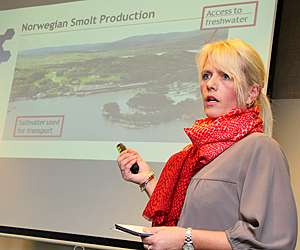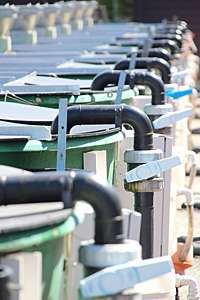Concerned by decline in smolts

Since 2006 there has been negative productivity growth in the Norwegian hatchery industry. "There is every reason for the salmon industry to be concerned when the productivity of such an essential supplier starts declining," asserts Hilde Ness Sandvold.
An analysis of the hatchery industry for the period 1988–2010 shows quintupled production volume along with a reduction of costs and smolt prices by 50 per cent. During the same period the number of hatchery facilities fell sharply, with dramatic increases in production volume per hatchery. The reduction in costs reflects notable technological advances and strong productivity growth.
Hilde Ness Sandvold of the University of Stavanger is a doctoral fellow under the Research Council of Norway's HAVBRUK programme. She is studying innovation and productivity growth in Norwegian hatchery production – and finds industry developments since 2006 troubling.
Innovation cut costs
"From 1988 to 2005 productivity rose rapidly, and Norwegian smolt producers helped to strengthen the competitiveness of the entire Norwegian salmon industry," explains Ms Sandvold. "But from 2006 to 2010 productivity dropped, and this trend has continued after 2010."
Lower productivity implies that it costs more per smolt to maintain production volume. This means more expensive smolts and higher costs for the consumer fish segment, which can weaken competitiveness.

The researcher points to innovations for eggs, feed, vaccine and technology – not least controlled lighting – as the main factors driving the strong productivity growth up to 2006.
"These advances led to year-round smolt production, greater flexibility for the seafood producers and more environment-friendly production," she continues. "We have quantified the economic impact of the various innovations by estimating the productivity boost they have given the industry over time."
Predictability fosters investment
In the 1988–2010 period the average annual productivity growth of the hatchery industry was a very robust 4.15 per cent. By comparison, farmed seafood producers had a productivity growth of 3.5 per cent. Ms Sandvold's analysis illustrates how innovations by suppliers improve the competitiveness of the entire industry.
"It is expensive to innovate," says Ms Sandvold, "but in the long run innovations pay off. The negative trend from 2006 onward indicates that the hatchery industry is finding it difficult to keep up the same pace of innovation as before. This poses a major challenge for the salmon farming industry at large."
Next she plans to take a closer look at the causes of reduced productivity in the hatchery industry.
"Our analysis does not directly address the causes of the negative growth," says Ms Sandvold. "There is good reason to believe that regulation may be a contributing factor. For instance, it has become more difficult to have new applications processed and have existing permits expanded. This could well be driving up costs."
In addition, the hatchery industry is dimensioned according to expectations for growth in total salmon production.
"Predictability in the industry is therefore important to ensure adequate willingness to invest in the future of Norwegian smolt production," Ms Sandvold concludes.
Provided by The Research Council of Norway



















